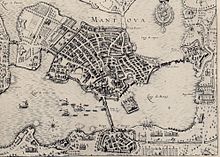War of the Mantuan Succession
| War of the Mantuan Succession | |||||||
|---|---|---|---|---|---|---|---|
| Part of the Thirty Years' War | |||||||
 |
|||||||
|
|||||||
| Belligerents | |||||||
|
Supporting the Duke of Nevers: |
Supporting the Duke of Guastalla: |
||||||
| Commanders and leaders | |||||||
|
|
|
||||||
The War of the Mantuan Succession (1628–31) was a peripheral part of the Thirty Years' War. Its casus belli was the extinction of the direct male line of the House of Gonzaga in December 1627. Brothers Francesco IV (1612), Ferdinando (1612–26) and Vincenzo II (1626–27), the last three dukes of Mantua from the direct line, had all died leaving no legitimate heirs. The war, fought among the backers of rival claimants, pitted France against the Habsburgs in a contest for control of northern Italy.
Mantua is the ancestral city where the male line of the Gonzaga dynasty ruled, first as marquesses, then after 1540 as dukes, in vassalage to the Holy Roman Empire.
Monferrato was a duchy since 1574 on the eastern side of Piedmont, and an Imperial fief since the eleventh or twelfth century. The Gonzagas had enlarged their realm with Monferrato after receiving it in dowry from the wife of duke Frederick II Gonzaga.
On 22 September 1612, Francis IV, Duke of Mantua and Monferrato died at the age of 26. His death occurred only a couple of months after the death of his father Vincent I, Duke of Mantua. He left only a three-year-old daughter, Maria of Mantua. Francis IV also had two younger brothers who, both being cardinals, could not marry and were thus ineligible to succeed to Mantua's throne.
...
Wikipedia
